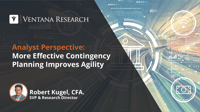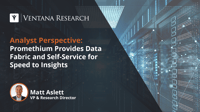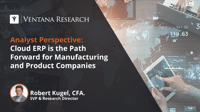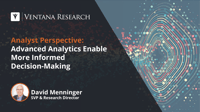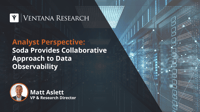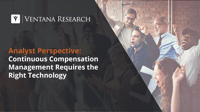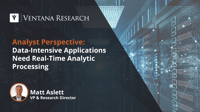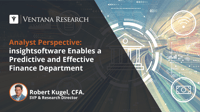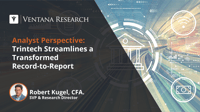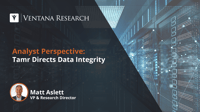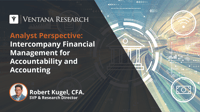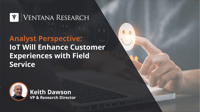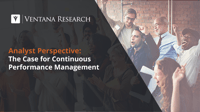We live in a time of uncertainty, not unpredictability. Managing an organization in uncertain times is always hard, but tools are available to improve the odds for success by making it easier and faster to plan for contingencies and scenarios. Software makes it possible to quickly consider the impact of a range of events or assumptions and devise a set of plans to deal with them. Dedicated planning and budgeting software has been around for decades but is about to become all the more useful as...
Read More
Topics:
Office of Finance,
Data Management,
Business Planning,
digital finance,
AI & Machine Learning
The market for data and analytics products is constantly evolving, with the emergence of new approaches to data persistence, data processing and analytics. This enables organizations to constantly adapt data analytics architecture in response to emerging functional capabilities and business requirements. It can, however, also be a challenge. Investments in data platforms cannot be constantly written-off as organizations adopt new products for new approaches. Too little change can lead to...
Read More
Topics:
Data Governance,
Data Management,
Data,
data operations
The cloud has come to dominate many business software categories, but until recently, enterprise resource planning for manufacturing and product-focused organizations has been a notable laggard. Cloud-based systems can be less costly to operate, perform better, be more secure and shift maintenance and update chores from the IT department to the vendor, freeing IT teams to concentrate on more strategic needs.
Read More
Topics:
Office of Finance,
Operations & Supply Chain,
Enterprise Resource Planning,
ERP and Continuous Accounting,
continuous supply chain,
digital finance
I’ve previously written about the analytics continuum, which spans a range of capabilities including reporting, visualization, planning, real-time processes, natural language processing, artificial intelligence and machine learning. I’ve also written about the analysis that goes into making intelligent decisions with decision intelligence. In this perspective, I’d like to focus on one end of the analytics continuum, which I’ll label advanced analytics.
Read More
Topics:
Analytics,
Digital Technology,
AI & Machine Learning,
Analytics & Data
Data observability was a hot topic in 2022 and looks likely to be a continued area of focus for innovation in 2023 and beyond. As I have previously described, data observability software is designed to automate the monitoring of data platforms and data pipelines, as well as the detection and remediation of data quality and data reliability issues. There has been a Cambrian explosion of data observability software vendors in recent years, and while they have fundamental capabilities in common,...
Read More
Topics:
Cloud Computing,
Data Management,
Data,
Digital Technology,
data operations,
Analytics & Data
Compensation management is the practice of strategically aligning worker pay with job roles, responsibilities and organizational objectives. It involves setting pay levels to ensure employees are adequately rewarded for their work while considering factors such as external economic trends, internal equity, budget constraints, tax regulations and compliance requirements.
Read More
Topics:
Human Capital Management,
Total Compensation Management
I have written about the increased demand for data-intensive operational applications infused with the results of analytic processes, such as personalization and artificial intelligence-driven recommendations. I previously described the use of hybrid data processing to enable analytics on application data within operational data platforms. As is often the case in the data platforms sector, however, there is more than one way to peel an orange. Recent years have also seen the emergence of...
Read More
Topics:
Cloud Computing,
Data,
Digital Technology,
Analytics & Data,
operational data platforms,
Analytic Data Platforms
insightsoftware provides applications for finance departments and other business users in midsize and larger organizations, offering a broad range of functions including analysis, internal and regulatory reporting, planning, consolidation, tax provision and treasury. The software brings together applications that enable business users to maximize data collected in existing systems and streamline the performance of a range of office of finance functions, all while limiting or eliminating the...
Read More
Topics:
Office of Finance,
embedded analytics,
Business Intelligence,
Business Planning,
Financial Performance Management,
ERP and Continuous Accounting,
digital finance,
profitability management,
Revenue, Lease and Tax Accounting
Trintech provides finance departments in midsize and larger organizations with software to accelerate their accounting close processes. This record-to-report (R2R) cycle is complex because it involves the coordination of numerous people, many systems and multiple sources of data. There are iterative portions that involve cycles of reviews and multiple levels of approvals. These include reconciliations and adjusting of entries during the close as well as authoring, editing and updating...
Read More
Topics:
Office of Finance,
Financial Performance Management,
ERP and Continuous Accounting,
digital finance
Organizations across various industries collect multiple types of data from disparate systems to answer key business questions and deliver personalized experiences for customers. The expanding volume of data increases complexity, and data management becomes a challenge if the process is manual and rules-based. There can be numerous siloed, incomplete and outdated data sources that result in inaccurate results. Organizations must also deal with concurrent errors – from customers to products to...
Read More
Topics:
Data Governance,
Data Management,
Data,
data operations,
Analytic Data Platforms
Ventana Research coined the term intercompany financial management (IFM) to define a discipline for structuring and handling transactions within a corporation and between its legal entities designed to maximize staff efficiency and accounting accuracy while optimizing tax exposure, minimizing tax leakage and ensuring consistent tax and regulatory compliance. Technology has advanced to a point where this approach is feasible and cost effective. For that reason, Ventana Research asserts that by...
Read More
Topics:
Office of Finance,
ERP and Continuous Accounting,
digital finance
The Internet of Things describes machines and objects that are enhanced with sensors and communication connections, enabling them to report on their operational status, including outages, faults or threshold conditions that require attention. The technology has gradually made its way into business and consumer systems over the past decade. Today, these connected devices are playing an important role in customer experience processes such as field service.
Read More
Topics:
Customer Experience,
Field Service,
Intelligent Self-Service
In January of 2020, I was head of product innovation for a newly launched product in the human capital management technology space, targeting high-volume hiring. We had big ambitions for that year, tied to product development and sales, all documented during our annual goal-setting and performance review process. And then the pandemic hit, and everything changed overnight. Everything, that is, except for my annual goals, or those of my team, which had already been set in stone. When the annual...
Read More
Topics:
Human Capital Management,
Talent Management
